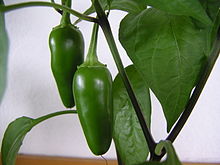Jalapeño
| Jalapeño | |
|---|---|

Immature jalapeños still on the plant
|
|
| Species | Capsicum annuum |
| Cultivar | Jalapeño |
| Origin | Mexico |
| Heat |
|
| Scoville scale | 1,000-20,000 SHU |
| Nutritional value per 100 g (3.5 oz) | |
|---|---|
| Energy | 121.336 kJ (29.000 kcal) |
|
6.50 g
|
|
| Sugars | 4.12 g |
| Dietary fiber | 2.8 g |
|
0.37 g
|
|
|
0.91 g
|
|
| Vitamins | |
| Vitamin A equiv. |
(7%)
54 μg |
| Thiamine (B1) |
(3%)
0.040 mg |
| Riboflavin (B2) |
(6%)
0.070 mg |
| Niacin (B3) |
(9%)
1.28 mg |
| Vitamin B6 |
(32%)
0.42 mg |
| Folate (B9) |
(7%)
27 μg |
| Vitamin C |
(143%)
118.6 mg |
| Vitamin E |
(24%)
3.58 mg |
| Vitamin K |
(18%)
18.5 μg |
| Minerals | |
| Calcium |
(1%)
12 mg |
| Iron |
(2%)
0.25 mg |
| Magnesium |
(4%)
15 mg |
| Phosphorus |
(4%)
26 mg |
| Potassium |
(5%)
248 mg |
| Sodium |
(0%)
3 mg |
| Zinc |
(1%)
0.14 mg |
| Other constituents | |
| Water | 91.69 g |
| Capsaicin | 0.01g – 6 g |
|
|
| Percentages are roughly approximated using US recommendations for adults. Source: USDA Nutrient Database |
|
The jalapeño (/ˌhæləˈpeɪnjoʊ/,/ˌhɑː-/, /-ˈpiːnjoʊ/, Spanish pronunciation: [xalaˈpeɲo]) is a medium-sized chili pepper pod type cultivar of the species Capsicum annuum. A mature jalapeño fruit is 5–10 cm (2–4 in) long and hangs down with a round, firm, smooth flesh of 1–1.5 in (25–38 mm) wide. It is of mild to medium pungency, having a range of 1,000 to 20,000 Scoville units, depending on cultivar. Commonly picked and consumed while still green, it is occasionally allowed to fully ripen and turn red, orange or yellow. It is wider and milder than the similar Serrano pepper.The Chile Pepper Institute is known for developing colored variations.
...
Wikipedia
